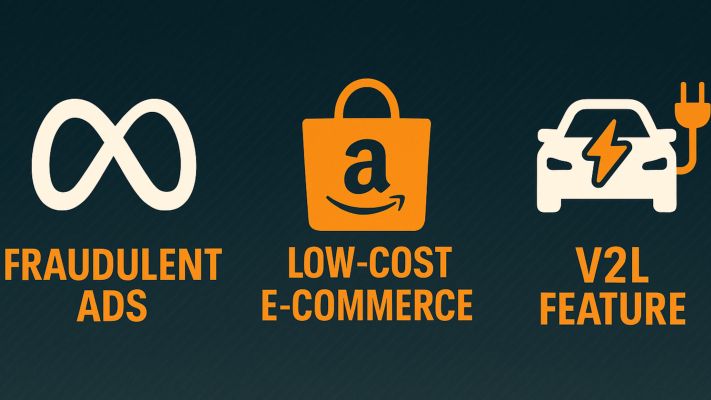AI Navigation
- articleAI Trends
- lightbulb_2AI Tips
- assistant_navigationAI Navigation
- heatHot Articles
- emergency_heat_2Hot Tips
- format_list_numberedPrompt Formatter
- psychologyTest Center(RPI)
November 10, 2025 · 24-Hour AI Briefing: Meta’s Ad Scandal, Amazon’s Low-Cost Offensive, and Tesla’s V2L Breakthrough
Summary:
In today’s tech landscape, the battle lines are no longer defined purely by innovation. Meta faces allegations of profiting from fraudulent ads, Amazon launches a global low-price counterattack, and Tesla expands its energy ecosystem. Behind these stories lies a deeper tension — a new era where ethics, supply chains, and ecosystems define the future of AI-driven giants.

Meta Accused of Profiting from Fraudulent Ads Worth Billions
Leaked internal documents suggest that around 10% of Meta Platforms’ 2024 annual revenue — roughly $16 billion — may have come from fraudulent or prohibited advertising. Meta’s spokesperson downplayed the findings, calling the numbers “rough estimates,” but offered no concrete data to dispute them.
Commentary:
The internal files reveal that Meta not only failed to detect high-risk ads effectively but even imposed a policy cap — “revenue loss must not exceed 0.15%” — on ad review actions. Worse, its algorithm reportedly amplifies scam content by pushing similar ads to users who click them, creating a vicious “click-and-trap” loop.
Elderly and digitally vulnerable users are hit hardest, effectively becoming the targets of algorithmic exploitation.
Even amid lawsuits and regulatory scrutiny across multiple countries, Meta appears to prioritize revenue stability over user safety.
Can you still trust the products owned by a company like this?
Amazon Expands Its “Bazaar” to 14 New Markets
Amazon announced the global expansion of Amazon Bazaar, its low-cost e-commerce service offering $10 dresses and $5 accessories.
Commentary:
With economic uncertainty rising and Western consumers growing more cost-conscious, demand for ultra-cheap goods is surging. Amazon Bazaar is clearly a counter-move against Chinese fast-fashion platforms like Temu, Shein, and AliExpress.
Amazon aims to leverage its logistics network and brand credibility to hold its ground in the price war and attract budget-sensitive shoppers.
However, most of these inexpensive products still come from suppliers in China and Southeast Asia. Without transparent supply-chain auditing, Amazon risks repeating H&M and Zara’s social-responsibility controversies.
And one more question looms large — how much collateral damage will this bring to Amazon’s independent sellers?
Tesla Model Y L Launches Vehicle-to-Load (V2L) Power Output
Tesla has officially rolled out AC external power output (V2L) capability for the Model Y L. After updating to software version 2025.32.300 or higher, and app version 4.50.5 or above, users can connect a special “AC V2L adapter” to power external devices. The feature is currently exclusive to the Model Y L.
Commentary:
This update signals Tesla’s formal entry into the practical V2L era. Beyond powering appliances during camping trips or blackouts, it represents Tesla’s response to growing competition from Chinese automakers such as BYD, Zeekr, and Xpeng — all of whom already offer robust V2L solutions.
For now, the function remains locked to one model and requires specific hardware. The key question is: how soon will Tesla bring this capability to the Model 3 or its upcoming Cybertruck?
It’s not just a feature race — it’s the foundation of Tesla’s broader energy ecosystem.
For more AI insights, business analysis, and frontier tech trends, visit:
https://iaiseek.com/en
Want to explore what happened in the AI world over the past 72 hours? Read:
November 8 · 24-Hour AI Briefing: Kimi Beats GPT-5, Quantum Leap from Helios, Burry Shorts NVIDIA, and AMD Enters the 2nm Era